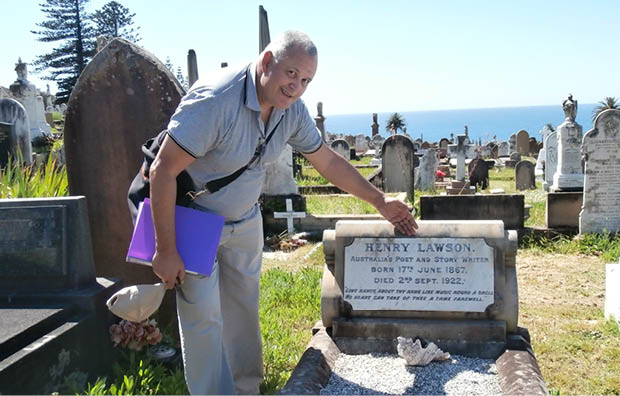HISTORIC CLIFFTOP CEMETERY IS A TREASURE TROVE OF MEMORIES AS JOHN McNAMEE DISCOVERS
As the young American daredevil climbed to his lofty perch 40 feet up in the circus tent Big Top, the anxious crowd yelled: “Don’t do it Charlie!”
“I never go down the same way as I go up,” the 24-year-old champion high diver shouted back defiantly.
Down below him on the ringside floor was a tank of water measuring eight foot long by six foot wide but only three foot in depth.
He’d performed similar stunts on his popular tour of Australia and was well known throughout his native America as a fearless high diver.
It was May 8, 1896 and Charles Owen Peart was performing for the then famous Fitzgerald Brother’s Circus near Redfern railway station in inner Sydney.
Charlie stood on his towering perch, stretched his arms up into the air and plunged gracefully off the tiny platform.
But to the horrified gasps of the audience, his plummeting body struck the thick metal side of the tank and he collapsed in mortal pain.
As he lay writhing in agony, circus workers raced to his aid and although he suffered catastrophic injuries, they noticed he had no visible outward signs of any broken bones or head injuries.
But, ominously, around his abdominal area was a large dark-blue bruise and he was rapidly losing consciousness.
With his last breath, Charlie reached out to take the hand of the circus owner and gasped: “I’m sorry Mr Fitzgerald, goodbye.”
The popular and fearless young American was given a big funeral and was laid to rest in Sydney’s famous Waverley Cemetery.
We stood by his simple grave during one of the regular tours of the historic site organised by the volunteer Friends of Waverley Cemetery and read the heartfelt words inscribed on his tombstone.
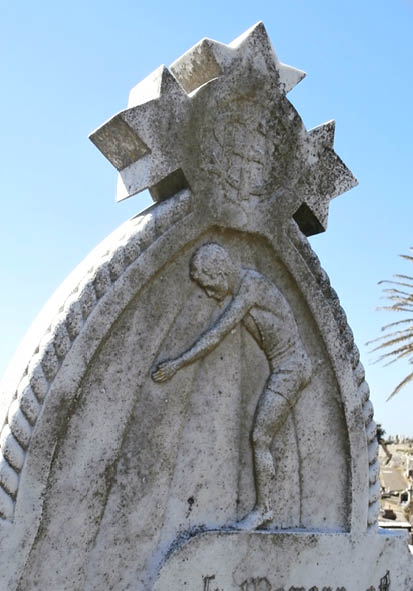
The weathered headstone of Charlie Peart showing the high diving champion in action
Just across the way is the family tomb of Harold Hardwick, (1888-1959) a champion boxer, swimmer and rugby union player and later war hero.
Harold won gold with the Australasian team at the 1912 Stockholm Olympics in the 4x200m freestyle relay. One of the country’s first great all-rounders, Harold in 1913 also won the national heavyweight boxing title.
Three years later he lost his title to the young up and coming champion Les Darcy but during the fiercely-fought contest, Hardwick knocked out most of Darcy’s teeth.
History records that this injury could have contributed to the infection which resulted in the great champion’s premature death at the age of 21 in 1917 in Memphis Tennessee, during his ill-fated American tour.
Our volunteer tour guide, Andrew Goffe, explains that the beautifully-landscaped cliffside cemetery which overlooks the ocean between Bronte and Clovelly beaches, is not classified as a “consecrated ground” so that alongside the famous heroes, statesmen, politicians and poets can lie the last resting places of the tragic suicide cases, violent gangsters, and whole families wiped out by the dreaded cholera outbreaks of the 1890s and early 1900s.
It’s hard to think of the cemetery which was founded in 1877 as a place of sadness as Andrew guided us through the pages of our nation’s history, on a wonderful Sydney spring day with the sun glinting off the sapphire-blue ocean and far out to sea, the spraying plumes of migrating humpbacks.
Great stories of our forebears abound..we were lucky to stand by the graves of such great Aussie poets as Henry Kendall, Dorothea MacKellar and of course, Henry Lawson, one of the most visited sites in the cemetery.
There are other Aussie icons such as Olympic swimmer Fanny Durack, aviation pioneer Lawrence Hargreaves and the legendary Test cricketer Victor Trumper all within easy walking distance.
The most spectacular monument would be the Irish memorial dedicated not only to the famous Irish republican leader, Michael Dwyer, known as the Wicklow Chief, who after being captured by the British during the bloody rebellion of 1798, was deported to Australia, but also to the heroes of subsequent Irish uprisings and more recently the martyrs of Long Kesh prison.
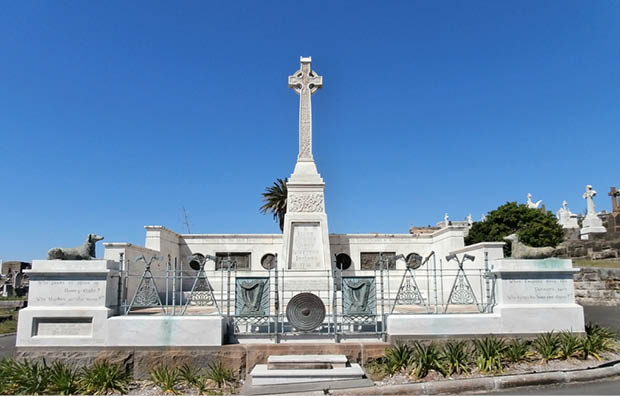
The spectacular Irish memorial dedicated to the ‘Wicklow Chief’ and other republican heroes
There are the rogues and cheats like infamous abortionist Dr Reginald Stuart Jones, (1902-1961), a well-known Sydney gynaecologist who was a notorious income tax cheat, dope peddler, heavy gambler who survived three attempts on his life by ruthless gunmen.
Nearby to this colourful identity, lie the remains of a former Chief Minister of NSW, Sir James Martin (1820-1886) who gave his name to Martin Place, in Sydney’s CBD hub.
Famous events in our colonial history are also highlighted in the closely sited graves of two of Sydney’s top legal eagles in Sir Robert Wisdom (1830-1888), a former NSW Attorney-General and his feisty courtroom opponent John “Jack” Want, another former NSW Attorney-General who famously clashed in the multiple murder trial of the feared bushranger, Andre George Scott….known as Captain Moonlight.
Moonlight and his gang of thugs were captured by police in November 1879 on a property known as Wantabadgery, in the NSW southern highlands, after the bushrangers had attacked the family homestead and held the terrified occupants hostage.
In the ensuing fierce gun battle, two hostages and three bushrangers were shot dead.
The vociferous defence lawyer Jack Want clashed heatedly many times during the trial with prosecutor Mr Wisdom but in the end and despite his fiendish legal skills he could not save Moonlight from the gallows.
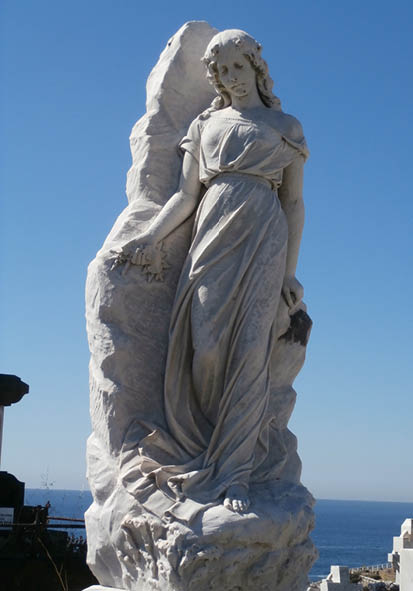
This angelic statue is regarded as one of the most beautiful sculptures in Waverley Cemetery
The two giants of Australian legal history are buried here just a short distance from each other.
The man who was to tie the noose around Moonlight’s neck at the Paddington gaol later that year, was Robert Howard, a former Hansom cab driver, who later became known as Nosey Bob the Hangman after his nose was kicked off by a horse.
Nosey Bob, who was infamous for his drunken botchings of executions at the gaol, also placed the rope around the neck of husband killer, Louisa Collins, the last woman hanged in NSW.
Nosey Bob died an alcoholic wreck in 1906 at the age of 73. Ironically, his grave too, is a short walk from the two prominent lawyers.
There is no end to the wealth of historic memories buried here but the heartening thing is that it is still a “working cemetery” and much revered in the nearby community as the resting places of hundreds of local family members.
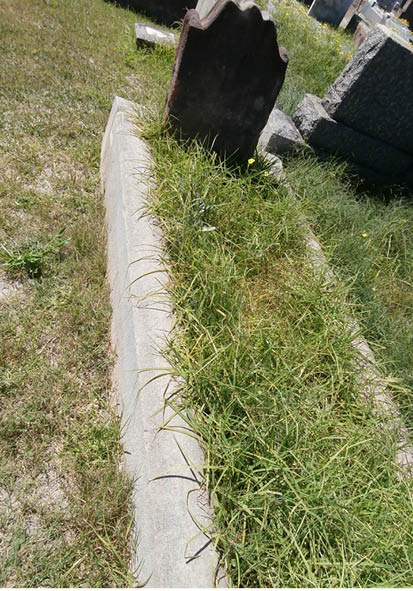
The humble overgrown grave of the street urchin known only as “wee davie”
Every weekend many people can be seen tending their family graves or placing flowers, or just spending quiet moments of reflection within a stone’s throw of the graves of some of the nation’s most famous people .
As we walked up the final stretch back to the cemetery office, Andrew said he wanted to point out a special grave to us.
It was a small weather-battered gravestone and the writing on it was crude and almost indecipherable.
Andrew explained it was dedicated simply to “Wee Davie”, a half-starved street urchin, who was knocked down and killed in 1878 by a horse-drawn cart.
The driver was so distraught he refused to let the boy go to a pauper’s grave and instead paid for the memorial himself.
The humble inscription reads: SOMEONE’S DARLING IS BURIED HERE.
- For more information contact Waverley Cemetery on 02 9665 4938 or email cemetery@waverley.nsw.gov.au
Main pic Tour guide Andrew Goffe at the grave of Henry Lawson…the most visited site in Waverley Cemetery


